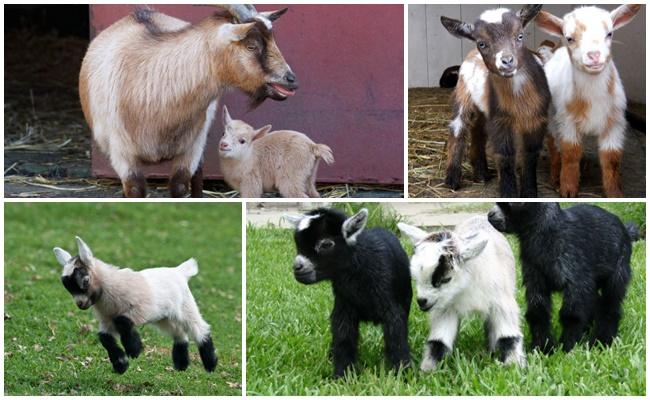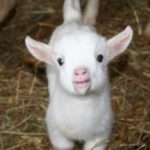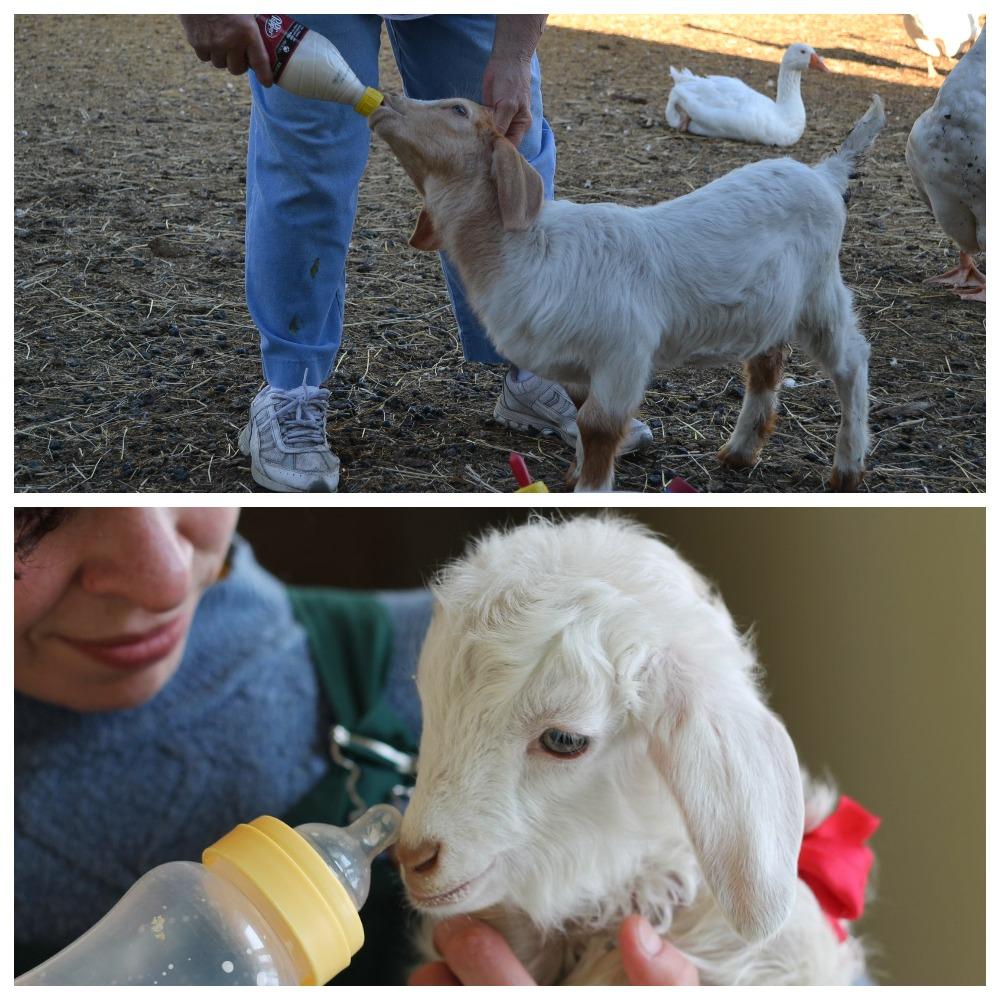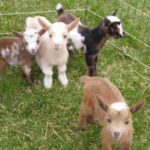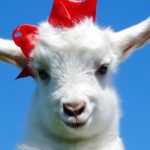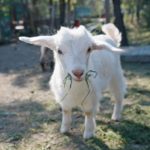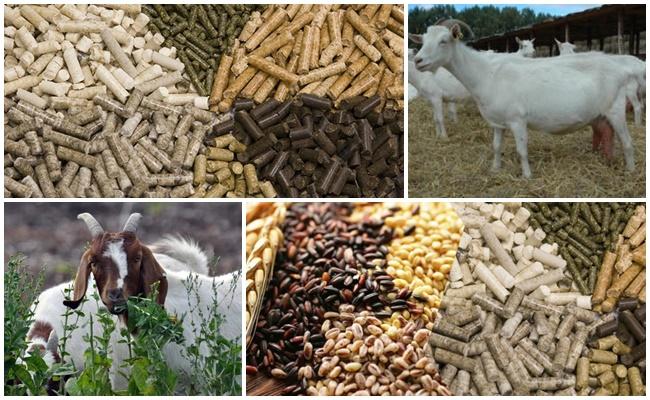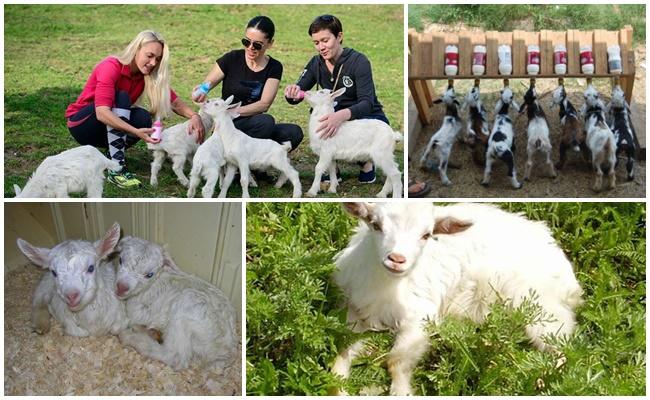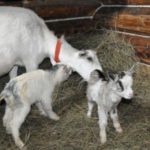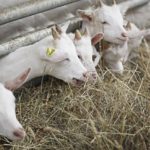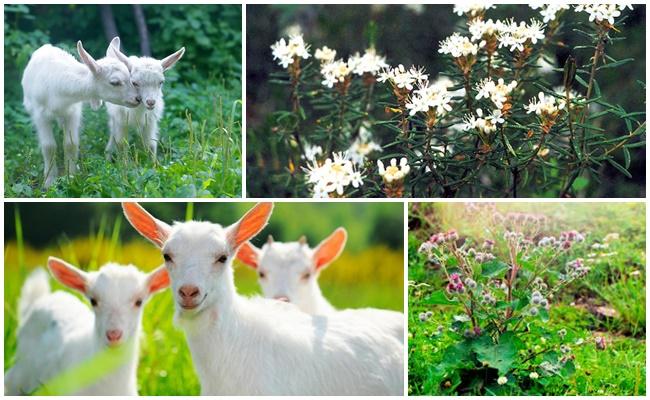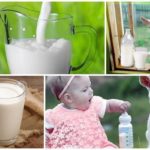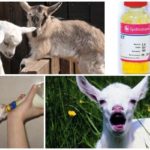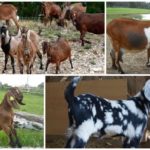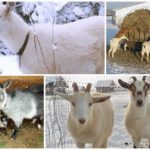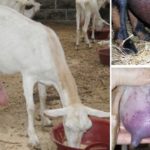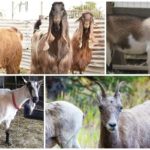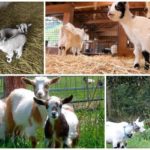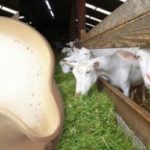The first days and hours of life of kids are a special stage of development, on which the development of immunity, future productivity and health in general depend. An important part of care is diet. The feeding method is chosen for goat kids depending on the breed, the characteristics of keeping and capabilities. Let's look at how to feed young goats, what should be introduced and what should be excluded from the diet.
Activities before the first feeding
Correct behavior during lambing and immediately after it will preserve the health of the mother goat and the young.What to do:
- If the kid's umbilical cord does not fall off on its own, it is cut off. Treat the cut with iodine or brilliant green.
- They wipe the eyes, muzzle, and body of the newborn from grease. To do this, use old soft rags or paper towels.
- They give the baby goat to the mother - licking increases the baby's immunity and protects against infections. When licking, the lactation process starts, colostrum arrives in the udder. Tactile contact is also important for a goat and a kid; mother and baby remember each other’s smell.
- The kid is wiped again and transferred to a warm place (in the house in winter).
- Washing the goat's udder. The first batch of colostrum is expressed and drained, as it may contain contaminants from the udder and dangerous microbes.
- Warm colostrum is fed to the baby goat. It is important to carry out the first feeding before the milk has cooled down.
You need to deal with postpartum care and feed the kid with colostrum in half an hour. If the baby does not receive warm colostrum within 30 minutes, the risk of postpartum complications increases several times. Without feeding, immune protection will not be formed in a timely manner; from 40 to 60% of the young animals die.
If the goat does not have milk or its quantity is too small, experienced people recommend:
- give the animal some sweet water to drink;
- try to milk, massage the udder;
- inject the hormone oxytocin.
The reason for the lack of milk is usually untimely start before birth, complications during lambing, lack of succulent food during feeding.
Feeding methods
The goat is able to feed the baby itself; human participation in the preparation of the diet is not necessary. But many people keep goat herds to produce milk, so they are interested in weaning the babies from the udder and feeding them artificially. Let's look at the features of each feeding method.
Under the uterus
Natural feeding is chosen if there is no need for milk; animals are bred to produce offspring, wool and skins. After lambing, the kids stay with their mother and eat when they are hungry. Advantages of the method:
- little goats do not need food rationing and tedious multiple feedings;
- young animals develop faster and learn from goats;
- Goat kids have stronger immunity;
- milk does not lose nutrients when poured into a bottle.
The kid sucks the udder at will; the owner does not need to monitor feeding, which reduces labor costs. After 3 weeks, mineral supplements are introduced into the diet - 10 grams of bone meal, chalk. When the kid turns 3 months old, the norm is doubled. When raised on natural feeding, the owner should monitor the condition of the goat’s udder and milk the remaining milk to prevent mastitis.
Artificial feeding
Cubs from dairy goats are taken away immediately after lambing and raised artificially. You also have to feed the kids if the goat is sick or there is no milk.
Advantages of artificial feeding:
- preserving commercial milk for consumption or sale;
- the ability to control the diet when feeding.
In the first days, colostrum and goat's milk are used for feeding, later - cow's milk, special mixtures, and mixed feed. Standards are calculated based on the age and health of the kids.
Disadvantages of this type of feeding:
- labor costs for forming a diet, time for feeding kids, washing dishes;
- weakened immunity and developmental delays in young animals.
For kids who do not receive mother's milk, it is important to introduce complementary foods according to their age and use vitamin supplements. First, the kids are fed from bottles with nipples; if there are a lot of kids, several nipples are attached to a drinking bucket.The young goats are transferred to the trough later so that the kids do not choke and eat more than normal.
Important: nipples need to be replaced in a timely manner, as the rubber gradually deteriorates, the size of the channels increases, babies swallow milk in large portions and choke.
Combined feeding
To feed young dairy goats, it is better to use combination feeding. Features of the method:
- For the first few days, the kids are fed by their mother. This allows you to lay the foundations of strong immunity - fresh milk contains everything necessary for the development of the baby.
- After 4-7 days, the kids are weaned from the udder. The goat is transferred to a dairy herd.
The kids eat in accordance with the developed diet and switch to artificial feeding. Complementary foods are received early, mineral supplements and milk formulas are combined to strengthen bones and immunity.
How many times a day should I feed?
If a baby grows up without a goat and receives human feeding, it is important to know the qualitative and quantitative norms. The following feeding frequency is recommended by age:
- 1-4 days – 5-6 times a day;
- 5-30 days – 4 times;
- 1-3 months - fed 3 times.
In the first days, the diet includes only milk, by the end of the third month they drink only once a day, the rest of the meals consist of solid food.
What can you give to goats?
Immediately after birth, the only food for goat kids is milk. Drinking colostrum is mandatory to activate the body's defenses. The immunostimulating power of colostrum weakens after 3-5 days. How does the diet change over time?
- 1-10 days – colostrum, milk;
- from the 11th day, complementary foods are introduced - oatmeal or semolina porridge (1 spoon of cereal per 500 grams of water), diluted with milk before feeding;
- from the month they give carrots, cabbage, beets;
- mandatory components - bran, feed;
- corn;
- hay.
At home, the following products are used as a dairy component:
- goat is ideal;
- You can give cow's milk in the absence of mother's milk from a goat;
- whole milk powder;
- substitute "Felucene".
Babies' stomach enzymes digest goat's milk better, so for early feeding it is better to choose mother's milk. The substitute consists of plant components, which makes it cheaper.
Young animals should be transferred to mixtures gradually (over 4-5 days), replacing natural food with artificial food in small portions.
How to properly prepare a diet for kids
It is important to feed colostrum to your newborn goat within the first hour. This stimulates the immune system, helps excrete feces, and saturates the body with microflora from the mother.
In the future, the feeding scheme is as follows:
| Age in days | Feeding frequency per day | Volume of milk per serving in grams | Oatmeal for complementary feeding in grams | Compound feed in grams | Root vegetables in grams | Hay in grams |
| 1-2 | 5-6 | 50 | ||||
| 3-4 | 5 | 80-110 | ||||
| 5-10 | 4-5 | 200-250 | ||||
| 11-21 | 4 | 300 | 200 | |||
| 22-30 | 4 | 300 | 300 | 30 | ||
| 31-40 | 3 | 350 | 500 | 50 | 40 | 50 |
| 41-50 | 3 | 250 | 700 | 100 | 60 | 100 |
| 51-60 | 3 | 150 | 800 | 150 | 100 | 150 |
| 61-70 | 3 | 150 | 800 | 200 | 200 | 150 |
| 71-80 | 3 | 150 | 200 | 250 | 200 | |
| 81-90 | 3 | 150 | 300 | 250 | 250 |
Main features of feeding according to age:
- From the first days, goat kids are fed every 3-3.5 hours using rubber nipples. It is better to use mother's milk. The colostrum of goats during the first days should be expressed, frozen, then heated in a water bath and given to the babies.
- Scrambled oatmeal and jelly are given from 10-11 days.
- By two weeks of age, the volume of milk is increased to 1.2 liters per day and is not increased any further. The norm for 1 time is 300-350 milliliters. At 2 weeks, the young animals are introduced to hay or greens.Grass food is kept in the feeder constantly so that the kids gradually get used to constant food, first lick it, then eat at will.
- In the third week, young animals are accustomed to concentrated feed, starting from 30 grams.
- Each month, milk for feeding is diluted with water; mashed boiled potatoes and bran can be added to it. Month-old kids are accustomed to roughage, and root vegetables are gradually introduced in small portions. The young animals are released onto pasture, where the kids try to get food themselves.
- At 2 months, roughage and grain become the basis of the diet. The share of milk does not exceed 30%. It is not economically profitable to feed two-month-old animals with milk.
Changes in diet are carried out slowly, new food is given in small portions, and the baby’s condition is monitored. Several new components should not be introduced at the same time. When switching to roughage, babies sometimes experience a decrease in weight gain and digestive disorders. Choose high quality feed, including premixes.
At 3 months, the grown young animals are transferred to adult food, and the childhood period ends. Feeding - twice a day according to the diet for goats:
- hay, fresh grass, silage;
- branches;
- vegetables, fruits and root vegetables in season;
- cereal components – crushed wheat, oats, corn;
- legumes;
- feed;
- vitamin supplements, premixes.
Animals' drinking bowls are constantly kept clean water, the temperature of which is not lower than 12 °.
What not to feed
All baits must be administered in small portions and in accordance with age, otherwise the baby’s gastric tract will not be able to digest food.
Goat's milk substitutes are less useful, so it is better to feed the young animals with mother's milk for 1-2 weeks.Not all components of fragrant herbs are equally beneficial for goats, and even more so for kids. There are many harmful and poisonous plants. Dangerous are:
- plants that are poisonous to goats with the possibility of death - hellebore, wolf bean, fern;
- severe poisoning - nightshade, wild rosemary, string, burdock, red clover, feather grass, thistle.
Children are not given food that is classified as spoiled:
- old, stale hay;
- hay infested with insects;
- fermented silage;
- vegetables, root crops with traces of rotting.
This type of food should not be fed to goats during natural feeding or given to older goats.
A thoughtful diet and strict adherence to feeding rules help kids quickly gain weight and grow cheerful and vigorous. After the appearance of young animals, the farmer has more worries. It is important to take care of kids in the first months in order to get highly productive and healthy animals.

